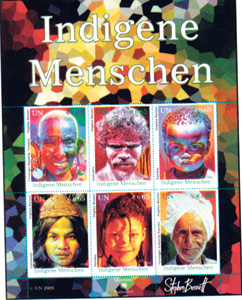We hear a lot about indigenous people. Who are they? There are many
definitions by numerous international organizations interested in the subject. Indigenous people have been described as
inheritors and practitioners of unique cultures and ways of relating to other people and to the
environment. These people have retained social,
cultural, economic and political characteristics that are distinct from those of the dominant societies in which they live.
The indigenous people of Sri Lanka are the Veddahs or 'Wanniyla-eththo'. They are a community of
forest- dwellers who have been absorbed into
mainstream society and have virtually given up their habit of hunting for existence and instead taken to farming.
The United Nations have estimated that there are more than 370 million indigenous people in about 90 countries worldwide. They are from diverse
geographical and cultural backgrounds but they share challenges such as lack of basic health care, limited access to education, loss of control over land, discrimination, forced assimilation, abject
poverty, displacement, human rights violations, and economic and social marginalization.
Over centuries,
indigenous people around the world have been
agitating for recognition of their identities, their ways of life and their right to
traditional lands, territories and natural resources. However, throughout
history their rights have been violated. They are perhaps among the most disadvantaged and
vulnerable groups of people in the world today. The international community has recognized that special measures are required to protect the rights of the world's indigenous people.
United Nations have been debating the issue for at least twenty years before adopting the UN Declaration on the Rights of Indigenous Peoples. This landmark event happened in September 2007 when the General Assembly approved it. It emphasizes the rights of indigenous peoples to live in dignity, to maintain and strengthen their own institutions,
cultures and traditions and to pursue their self-
determined development in keeping with their needs and aspirations.
The UN Declaration is the most comprehensive statement of the rights of indigenous peoples ever developed. It gives
prominence to collective rights to an unprecedented level in international human rights law. It is the clearest indication that the international community is committing itself to the protection of the individual and collective rights of these peoples.
Eighteen commemorative stamps were issued last year by the UN Postal Administration on the theme 'Indigenous People'. The stamps were released in three mini-sheets each with six stamps featuring indigenous people from different parts of the world. The stamps depict a mix of faces – young, old, joyful and withered.
While the faces have been picked from among indigenous people from different parts of the world, they present an assortment of their
characteristic features.
For example, most of them have unusual hair styles or they sport
distinctive head gear. Their skin colour also varies. (Note the neck ornament from Thailand or the green beads from Tanzania.)
The designer of the stamps, Stephen Bennett from USA is a dedicated portrait painter who
travels around the world every year to paint
portraits of indigenous people.
He is reputed as a painter who has a keen sense of observation with an ability to bring out the beauty of a face.
Describing him, the UN Philatelic Bulletin says he has a special ability to express and bring light to a face by his play with colours. For him, a face is a treasure, it adds.
He is working towards
completing an
international exhibition of 1000 portraits from the world over painted by his own hand. |




